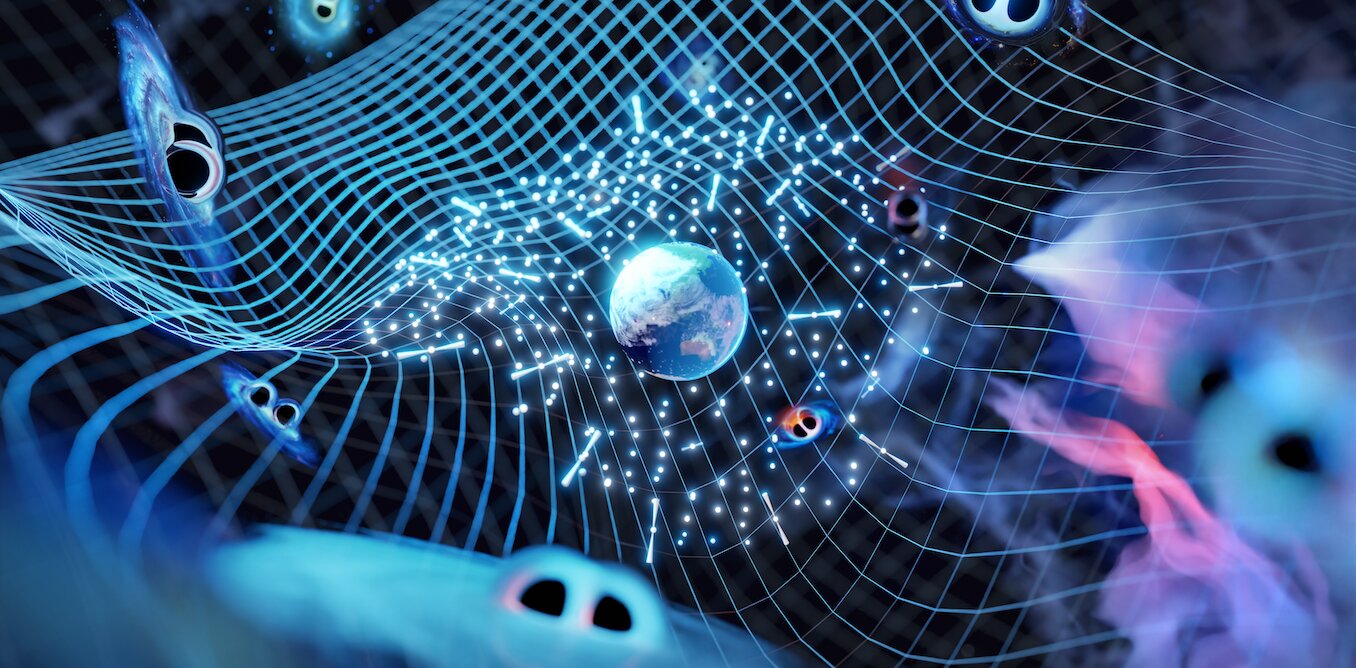Astonishing discoveries have been made by astronomers regarding the enigmatic phenomenon of gravitational waves. When massive objects such as black holes orbit one another, they generate ripples in the fabric of space and time, unveiling secrets about these cosmic giants. While high-frequency gravitational waves, known as “chirps,” have been observed from colliding black holes, detecting the ultra-low-frequency rumble produced by supermassive black holes has proven more challenging. However, an international collaboration, including the Parkes Pulsar Timing Array, has now unveiled their most compelling evidence to date of these elusive waves.
Gravitational waves, as elucidated by physicist Albert Einstein in his groundbreaking general theory of relativity in 1915, are produced when massive objects distort the four-dimensional “fabric” of spacetime. These waves propagate at the speed of light, but their creation demands an immense amount of energy. Consequently, Einstein was skeptical that they could ever be directly observed. However, in a remarkable turn of events, the LIGO and Virgo collaborations detected gravitational waves stemming from the collision of two black holes seven years ago. Now, radio astronomers across the globe have discovered hints of ultra-low-frequency gravitational waves, generated by pairs of supermassive black holes situated at the cores of galaxies throughout the universe. Detecting these waves would necessitate a detector of galactic proportions, but astronomers have found a solution by using pulsars, which are already distributed across the galaxy and emit regular pulses akin to precise clocks.
For nearly two decades, CSIRO’s Parkes radio telescope, Murriyang, has been monitoring an array of pulsars. The Parkes Pulsar Timing Array, alongside other collaborations in China, Europe, India, and North America, has now reported similar signals pointing towards gravitational waves. The phenomenon being observed is an indiscriminate “ocean” of gravitational waves, generated by countless pairs of supermassive black holes throughout the universe. Unveiling these waves not only confirms Einstein’s theory but also serves as a significant step forward in understanding the evolutionary history of galaxies. Supermassive black holes, which act as the engines powering galaxies, play a vital role in gas consumption and star formation regulation. The signals associated with gravitational waves appear as a low-frequency rumble magnified in all pulsars within the array. As these waves distort spacetime around Earth, they affect the arrival times of radio waves emitted by distant pulsars.
The stretching and squeezing of our galaxy induced by gravitational waves ultimately alters the distances to pulsars by a minuscule amount. Despite the pulsars typically being located about 1,000 light-years away, equivalent to approximately 10,000,000,000,000,000,000 meters, the shifts in spacetime manifest as nanosecond delays in pulses, which can be easily tracked by radio astronomers due to the inherent stability of pulsars. The detection of ultra-low-frequency gravitational waves is a step-by-step process, with researchers initially observing a general rumble in the pulsars, unaware of its origin. However, the unique signature of gravitational waves is now starting to emerge, evidenced by the pulsar timing array collaborations across the globe. This signature manifests as a distinct relationship between the similarity of pulse delays and the angular separation between pairs of pulsars in the sky. Pulsars situated closely display a more alike signal compared to pulsars separated at right angles.
Advancements in technology at observatories, such as the Parkes Pulsar Timing Array’s utilization of advanced receivers and signal processing technology on Murriyang, have been instrumental in achieving these groundbreaking results. The Parkes Pulsar Timing Array possesses the most extensive, high-quality data set, as it has been able to discover numerous exceptional pulsars employed by collaborations worldwide in their pursuit of gravitational waves. Previous observations indicated a lack of the expected signal associated with gravitational waves in pulsars. However, recent analyses of segmented, shorter time slices from the data set indicate that the signal is progressively growing over time. The cause of this observation remains uncertain, but it is plausible that gravitational waves are behaving in an unexpected manner. To confirm the existence of ultra-low-frequency gravitational waves, the global collaborations must combine their data sets, significantly enhancing their sensitivity to such waves. Efforts to create this consolidated data set are already underway through the International Pulsar Timing Array project.
The recent discovery of ultra-low-frequency gravitational waves is tremendously exciting for astronomers, and confirmation of these findings would greatly contribute to our knowledge of the universe’s history. Future observatories like the Square Kilometre Array, currently under construction in Australia and South Africa, will further enrich our understanding of the universe through extensive studies of gravitational waves.
Denial of responsibility! TechCodex is an automatic aggregator of the all world’s media. In each content, the hyperlink to the primary source is specified. All trademarks belong to their rightful owners, and all materials to their authors. For any complaint, please reach us at – [email protected]. We will take necessary action within 24 hours.

Jessica Irvine is a tech enthusiast specializing in gadgets. From smart home devices to cutting-edge electronics, Jessica explores the world of consumer tech, offering readers comprehensive reviews, hands-on experiences, and expert insights into the coolest and most innovative gadgets on the market.


